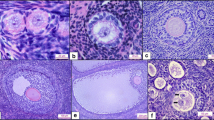Abstract.
The zona pellucida of mammalian oocytes plays an important role in binding and activation of sperm cells during the molecular events leading to fertilization. The genes coding for the three zona pellucida glycoproteins ZPA, ZPB, and ZPC of various species including mouse, dog, and human have been cloned and sequenced by several groups. However, it has remained a matter of debate as to whether the oocytes alone or in conjunction with the surrounding granulosa cells express and deposit these proteins to form the zona pellucida matrix. Addressing this unresolved issue, we assessed the expression and localization of all three zona pellucida proteins in ovaries of human, cynomolgus monkey and mice using immunohistochemical methods. In addition, oocyte-specific expression of ZPC from the primordial stage onward was confirmed by in situ hybridization. In sections of human ovaries, ZPA, ZPB, and ZPC proteins were immunohistochemically detected in the cytoplasms of primordial oocytes and during later stages of folliculogenesis in the zona pellucida matrices of oocytes. In sections fixed with formalin, a clear homogeneous ring was visible around the oocyte and no staining of granulosa cells was observed. In contrast, staining of ZP proteins was also observed between granulosa cells when Bouin's reagent had been used for tissue fixation. Thus, the original zona pellucida architecture was better preserved by formalin fixation. We further demonstrated that dissolution of the zona pellucida of isolated bovine oocytes occurred after they were exposed to Bouin's reagent. In summary, these results demonstrate that in mice, monkeys and humans, zona proteins are expressed and assembled exclusively by the oocyte and not by the granulosa cells. Previously observed results of ZP expression by an involvement of granulosa cells might therefore be the result of an improper fixation of the tissues leading to the disruption of the zona pellucida. Additionally this study highlights the importance of choosing the correct fixative for immunohistochemistry, not only for the usual reason of retaining antigenicity, but rather to retain the entire architectural structure.
Similar content being viewed by others
Author information
Authors and Affiliations
Additional information
Electronic Publication
Rights and permissions
About this article
Cite this article
Eberspaecher, U., Becker, A., Bringmann, P. et al. Immunohistochemical localization of zona pellucida proteins ZPA, ZPB and ZPC in human, cynomolgus monkey and mouse ovaries. Cell Tissue Res 303, 277–287 (2001). https://doi.org/10.1007/s004410000287
Received:
Accepted:
Issue Date:
DOI: https://doi.org/10.1007/s004410000287




